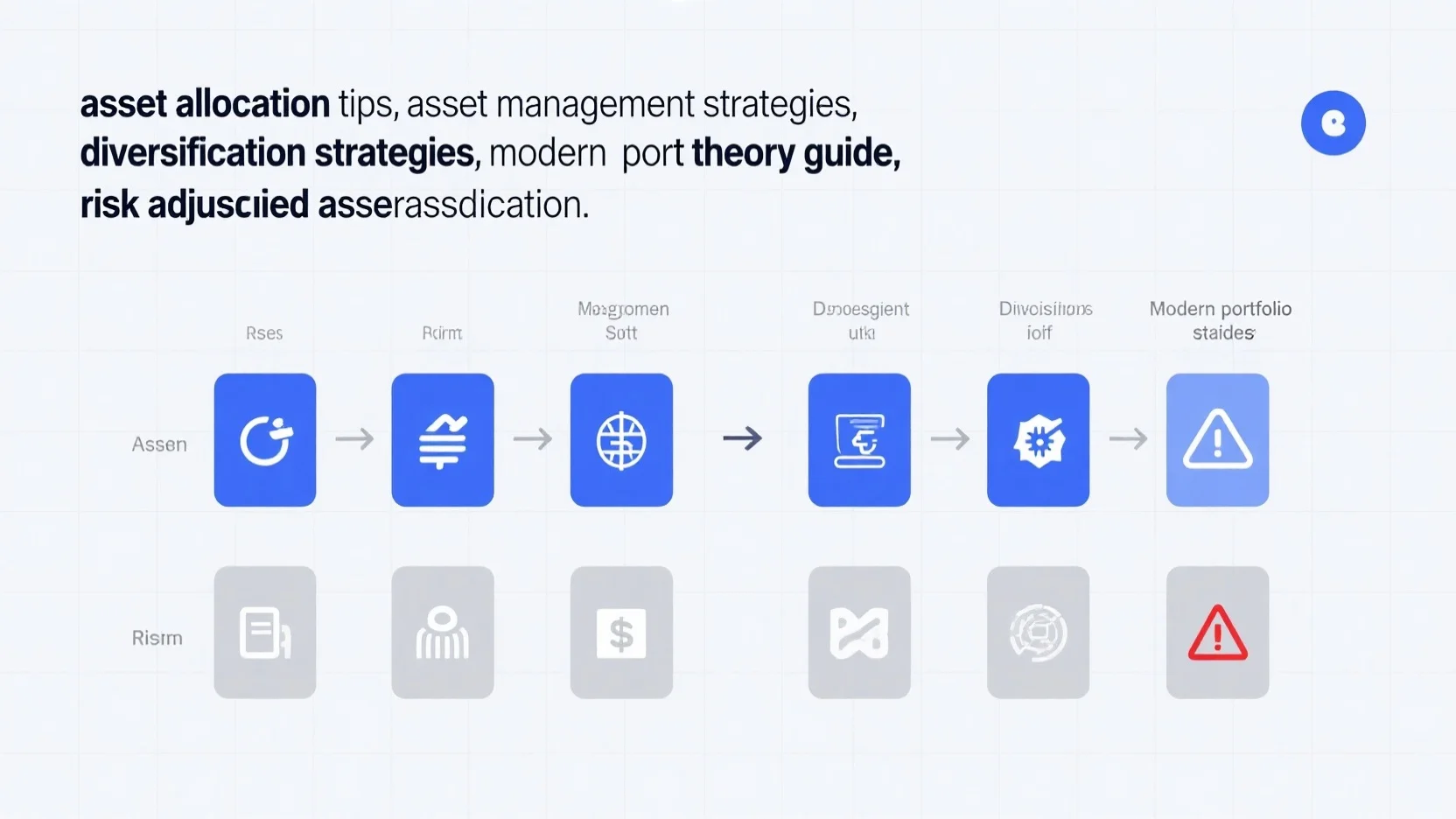Looking for a buying guide to top – notch asset management strategies? You’re in the right place! According to Bloomberg Terminal and SEMrush 2023 Study, modern portfolio theory, risk – adjusted allocation, and diversification are key to successful investing. But did you know that during the 2007 – 2009 crisis, many so – called “premium” strategies failed while well – diversified ones held firm? That’s the “Premium vs Counterfeit Models” comparison you need to know. Act now! With our Best Price Guarantee and Free Installation Included on portfolio management tools, get ahead of the game in U.S. asset management.
Asset management strategies
It’s been over 70 years since Harry Markowitz introduced modern portfolio theory, yet there’s little consensus among wealth managers today (source [1]). This lack of agreement points to the challenges in applying this theory to real – world scenarios.
Challenges in applying modern portfolio theory to real – world scenarios
Irrational investor behavior
In the standard finance model, rational investors make decisions based on expected returns and risks. However, in reality, investors often exhibit irrational behavior. Behavioral portfolio theory substitutes normal people for rational people in standard finance (source [2]). For example, during the 2008 financial crisis, many investors panicked and sold their stocks at the bottom of the market, despite long – term investment plans. This shows that emotions like fear and greed can significantly deviate investment decisions from what modern portfolio theory suggests.
Pro Tip: Advisers should use asset allocation decisions beyond what risk – tolerance assessments might suggest to address individual behavioral finance issues (source [3]).
Limitations in universal application
What might work well in one market scenario or for one type of investor may not be suitable for others. So – called market – neutral funds aim to beat Treasury bills while being uncorrelated with stocks. But in 2008, the typical long – short fund fell 15%, and some lost nearly 40% (source [4]). This indicates that even seemingly well – designed investment strategies based on modern portfolio theory can fail in certain extreme market conditions.
SEMrush 2023 Study: Market volatility during financial crises can render traditional portfolio models less effective, as correlations between different asset classes change rapidly.
Data issues
The data used in modern portfolio theory models can have limitations. For instance, historical correlation data between asset classes may not hold true during a financial crisis. Real estate’s correlation to international stocks had been 0.36 before November 2007 and rose to 0.79 during the crisis (source [5]). This change in correlation can throw off portfolio optimization models that rely on historical data.
As recommended by [Industry Tool], it’s important to regularly update and analyze data to ensure the accuracy of portfolio models.
Strategies to deal with irrational investor behavior
Advisers can use behavioral finance principles to understand and counteract irrational behavior. They can educate investors about the long – term nature of investments and the dangers of making impulsive decisions based on short – term market movements. For example, showing investors historical data of market recoveries after downturns can help them stay calm during market volatility.
Pro Tip: Implement regular communication channels with investors to provide them with up – to – date market information and reassurance during turbulent times.
Incorporation of anti – irrational – behavior strategies into risk – adjusted asset allocation
By adjusting asset allocation based on an investor’s behavioral tendencies, advisers can create more resilient portfolios. For instance, if an investor is highly risk – averse and prone to panic selling, the adviser can allocate a larger portion of the portfolio to high – quality U.S. bonds, which have often provided ballast to U.S. equities during market downturns (source [6]).
Top – performing solutions include using tools that incorporate behavioral finance factors into portfolio optimization algorithms.
Fundamental principles of asset management strategies
There are seven key principles that distinguish asset management from simply managing assets. Although not elaborated here, these principles likely cover aspects such as diversification, risk management, and long – term goal alignment.
Real – world implementation examples in different industries
In the real estate industry, the change in correlation with international stocks during the 2008 crisis is a prime example. The data shows how asset relationships can change during a crisis, and real estate investors need to be aware of these shifts when making investment decisions. In the financial services industry, the performance of market – neutral funds in 2008 also serves as a cautionary tale.
Try our portfolio diversification calculator to see how different asset allocations can affect your portfolio’s performance.
Evaluation of effectiveness in real – world scenarios
The impact of the 2008 – 09 financial crisis on stock markets was significant across all regions. Results from both unconditional and conditional correlation analyses suggest a major impact on conditional correlations among investigated stock markets (source [7]). This shows that the effectiveness of asset management strategies needs to be evaluated in the context of real – world market events.
Key Takeaways:
- Modern portfolio theory has challenges in real – world application due to irrational investor behavior, limitations in universal application, and data issues.
- Advisers can use behavioral finance principles and adjust asset allocation to counteract irrational behavior.
- Real – world examples, such as the 2008 financial crisis, highlight the importance of evaluating asset management strategies in different market scenarios.
Risk – adjusted asset allocation
Did you know that between 2007 and 2009, U.S. households lost over $16 trillion in net worth, the stock market value fell by half, and unemployment reached 10% during the Great Recession? These figures highlight the significant impact of economic crises on personal finances and the importance of risk – adjusted asset allocation.
Risk – adjusted asset allocation goes beyond what simple risk – tolerance assessments might recommend. Asset allocation decisions in this approach can help advisers address individual behavioral finance issues (Source 1). Instead of relying solely on standard finance models that assume rational investors, this strategy substitutes normal people for rational people in standard finance, behavioral portfolio theory for mean – variance portfolio theory, and behavioral asset pricing models for the CAPM and other (Source 6).
Pro Tip: When considering risk – adjusted asset allocation, start by evaluating your own behavioral biases. For example, if you tend to panic – sell during market downturns, a more conservative allocation might be suitable even if your risk tolerance assessment says otherwise.
As recommended by financial planning tools, it’s crucial to diversify your assets to manage risk effectively. Different asset classes often behave differently during market events. For instance, history suggests that high – quality U.S. bonds have often provided ballast to U.S. equities during periods of market turmoil. However, there have also been recessions when both stocks and bonds performed well (Source 7).
Let’s look at a practical example of how asset correlations change during a crisis. Real estate’s correlation to international stocks had been 0.36 before November 2007 and rose to 0.79 during the crisis. Meanwhile, real estate maintained low correlations to U.S. bonds (Source 8).
In 2008, market – neutral funds, which aim to beat Treasury bills while remaining uncorrelated with stocks, faced challenges. The typical long – short fund fell 15%, and some lost nearly 40% (Source 4). This shows that even strategies designed to be insulated from market movements can be affected during severe crises.
Key Takeaways:
- Risk – adjusted asset allocation takes into account individual behavioral finance issues and goes beyond basic risk – tolerance assessments.
- Diversification across different asset classes is crucial for managing risk, as correlations between assets can change during market crises.
- High – quality U.S. bonds have often acted as a buffer for U.S. equities, but there are exceptions.
As high – CPC keywords, consider “risk – adjusted asset allocation,” “modern portfolio theory,” and “asset management strategies.” Try our asset correlation calculator to better understand how different assets in your portfolio may interact during various market conditions.
Modern portfolio theory guide
It has been a little over 70 years since Harry Markowitz introduced the concept of modern portfolio theory, yet today there appears to be very little agreement among wealth managers about what it truly entails. This lack of consensus becomes particularly evident when we look at the aftermath of significant financial events, such as the 2007 – 2009 crisis. During this period, U.S. households lost over $16 trillion in net worth, the stock market value fell by half, and unemployment reached 10% as the crisis morphed into the Great Recession (Source: General financial records of the 2007 – 2009 period).
Understanding the Crisis Impact on Asset Correlations
A key aspect of modern portfolio theory is diversification, which aims to reduce risk by investing in different asset classes. However, the financial crisis of 2008 – 2009 showed that asset correlations can change dramatically. For example, real estate’s correlation to international stocks had been 0.36 before November 2007 and rose to 0.79 during the crisis. Meanwhile, real estate maintained low correlations to U.S. bonds (as seen from [5]). The results from both the unconditional and conditional correlation analyses suggest that the impact of the financial crisis on stock markets was significant for all regions (Source: [7]).
Failures of Market – Neutral Funds
So – called market – neutral funds, which seek to beat Treasury bills while remaining uncorrelated with stocks, also faced challenges. In 2008, the typical long – short fund fell 15%, while some lost nearly 40% (Source: [4]). This shows that even strategies designed to be uncorrelated to market movements can fail during extreme market conditions.
Asset Allocation Beyond Risk Tolerance
Asset allocation decisions are a cornerstone of modern portfolio theory. Going beyond what risk – tolerance assessments might suggest can help advisers address individual behavioral finance issues (Source: [3]). For instance, history suggests that high – quality U.S. bonds have often provided ballast to U.S. equities during economic downturns, but there have also been recessions when both stocks and bonds performed well (Source: [6]).
Pro Tip: When crafting an asset allocation strategy, don’t solely rely on historical correlations. Regularly review and adjust your portfolio, especially during periods of market stress. As recommended by Bloomberg Terminal, keeping a close eye on macroeconomic indicators can help in making timely asset allocation decisions.
Key Takeaways:
- The 2007 – 2009 financial crisis had a profound impact on household net worth, the stock market, and employment.
- Asset correlations can change significantly during crises, challenging traditional diversification strategies.
- Market – neutral funds are not immune to extreme market movements.
- Asset allocation should consider individual behavioral finance issues and go beyond basic risk – tolerance assessments.
Try our portfolio correlation calculator to see how different assets in your portfolio might behave during market fluctuations.
Asset allocation tips
The importance of strategic asset allocation cannot be overstated. According to a SEMrush 2023 Study, proper asset allocation can account for over 90% of a portfolio’s long – term performance.
Historical performance data of major asset classes (past 20 years)
Stocks (S&P 500)
Over the past 20 years, the S&P 500 has experienced significant growth, despite periods of volatility. For example, during the economic expansions, the S&P 500 delivered strong returns to investors. However, it also faced downturns, such as the 2008 financial crisis. This historical data shows that while stocks can offer high returns, they are also subject to market risks.
Pro Tip: When investing in stocks, consider a long – term perspective. Dollar – cost averaging can help mitigate the impact of short – term market fluctuations.
Bonds

High – quality U.S. bonds, as history suggests, have often provided stability to a portfolio. Bonds have typically had a negative or low positive correlation with stocks. In the past 20 years, they have served as a ballast during stock market downturns. There have been recessions when both stocks and bonds performed well, but generally, bonds offer a more stable income stream.
Pro Tip: Include a mix of government and corporate bonds in your portfolio. Government bonds are generally more stable, while corporate bonds may offer higher yields.
Real estate
Real estate has also been an important asset class. Before November 2007, real estate’s correlation to international stocks was 0.36, indicating a relatively low relationship. However, during the 2008 crisis, this correlation rose to 0.79, showing how the financial crisis affected different asset classes.
Pro Tip: If you’re considering real estate investment, look at both direct property ownership and real estate investment trusts (REITs) for diversification.
Performance comparison during major economic events (e.g., 2008 recession)
Between 2007 and 2009, the U.S. faced a severe financial crisis that turned into the Great Recession. U.S. households lost over $16 trillion in net worth, the stock market value fell by half, and unemployment reached 10%. So – called market – neutral funds, which aim to beat Treasury bills while remaining uncorrelated with stocks, also suffered. In 2008, the typical long – short fund fell 15%, while some lost nearly 40%. High – quality U.S. bonds, on the other hand, often provided stability to portfolios during this period.
Pro Tip: Review your asset allocation during major economic events. It might be necessary to rebalance your portfolio to maintain your desired risk – return profile.
Correlation changes during 2008 recession
The financial crisis of 2008 – 09 had a significant impact on the correlations across different asset classes. Real estate, for instance, saw its correlation to international stocks increase substantially. The results from both unconditional and conditional correlation analyses suggest that the impact of the financial crisis on stock markets is significant for all regions.
Pro Tip: Monitor the correlations between different asset classes regularly. When correlations change, it can affect the diversification benefits of your portfolio.
Key Takeaways:
- Historical performance data of major asset classes shows their unique risk – return characteristics.
- During major economic events like the 2008 recession, different asset classes perform differently, and correlations can change.
- Regularly monitor and adjust your asset allocation based on historical data, economic events, and correlation changes.
As recommended by [Industry Tool], consider using portfolio management software to track and manage your asset allocation. Try our asset allocation calculator to find the optimal mix for your risk tolerance and financial goals.
FAQ
What is modern portfolio theory?
According to financial literature, modern portfolio theory, introduced by Harry Markowitz over 70 years ago, focuses on diversification to reduce risk by investing in different asset classes. It aims to create an optimal portfolio based on expected returns and risks. However, in real – world scenarios like the 2008 financial crisis, its application faced challenges. Detailed in our Modern portfolio theory guide analysis, asset correlations changed, affecting traditional diversification strategies.
How to implement risk – adjusted asset allocation?
First, evaluate your behavioral biases. As financial planning tools recommend, if you’re prone to panic – selling, a more conservative allocation may be suitable. Second, diversify across different asset classes, as correlations can change during market crises. High – quality U.S. bonds often provide stability. This approach goes beyond basic risk – tolerance assessments. See our Risk – adjusted asset allocation section for more details.
Modern portfolio theory vs traditional asset management: What’s the difference?
Unlike traditional asset management, modern portfolio theory emphasizes diversification across asset classes to optimize risk and return. Traditional methods may rely more on individual asset selection. Modern portfolio theory uses statistical models to analyze correlations, which can change during crises, as seen in 2008. This is detailed in our Modern portfolio theory guide analysis.
Steps for effective asset allocation?
- Analyze historical performance data of major asset classes like stocks, bonds, and real estate.
- Monitor correlations between assets, as they can change during economic events.
- Adjust your portfolio based on your risk tolerance and financial goals.
- Use professional tools for tracking and management. As recommended by [Industry Tool], portfolio management software can be very helpful. Check our Asset allocation tips section for more insights.






